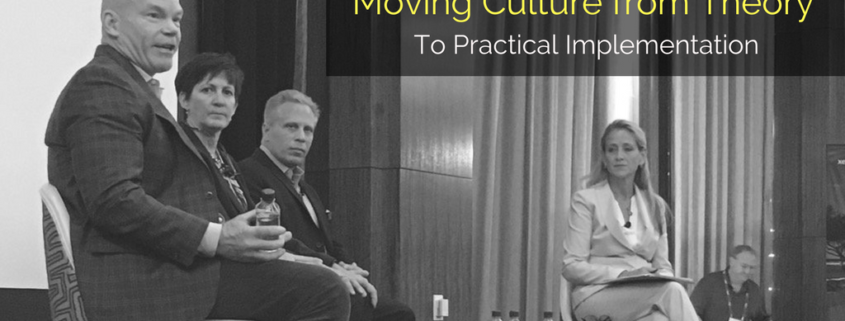Moving Culture From Theory to Practical Implementation
posted by Arial Harland on Monday, September 18, 2017 in Office Equipment Blog
In our hearts, we believe culture matters. Organizations that cultivate a positive culture around a set of shared values recognize it as a powerful driver of engagement, which has been linked to better financial performance. (See article)
Realizing this, business owners find themselves focused more on building culture. For some, it’s difficult to take what we know in our hearts and minds and translate this into practical implementation in our day-to-day world.
Real world examples of implementation were on tap at the BTA National Conference in August. Three dealer panelists shared how they have embraced culture as a means to evolve their business. The panel moderated by Jennie Fisher of GreatAmerica Financial Services offered attendees the chance to learn from their first-hand experience.
Brett Butler, CEO of Excel Office Services
As his company made the transition from a transactional sales organization to a services business, Brett found that culture is really defined by three pieces, where his employees would be empowered to evolve with the business.
- Alignment. Are we all-in with the dream of where we are going as a company?
- Motivation. What is the motivation? Do you wake up every morning and say, ‘Man I can’t wait to wake up and capitalize on this opportunity?’
- Purpose. When we talk about Millennials, they want to have a purpose in their lives. It’s not just about around Christmas time we’re going to go feed the poor, but every day when I wake up do I have purpose in what I do? Our purpose is to grow.
“When you go from a transactional sales organization to a services business, it’s not just the sales people who are delivering on the brand and the promise; it’s the support people who deliver the services and the support, that cash the check, the sales people write, in order to deliver on the promise of our brand. Our brand is high value, high touch.
Brett also modified the way he advertises for new employees by highlighting elements of his business that have the greatest cultural relevance:
- Good real-estate with a modern space that’s dog friendly
- Employee perks: company BBQs, quarterly trips, indoor skydiving, etc.
- Personal development plans and mentorship programs
- Cultural awards and recognition programs
Above all, Brett is building a business where everyone is committed to growth. The tide will raise all boats.
Debra Dellaposta, President and CEO of Doing Better Business, Inc.
Debbie’s approach to culture is altruistic: “For me, focusing on culture was more about how we all spend so much time at work. I want it to be a fun place. I want to enjoy going to work, I didn’t want to dread going to work, and I wanted people who work with me to feel the same way.”
Debbie has found many practical ways to create an open culture, and focuses specifically on transparency. When onboarding employees, Debbie opens the books “I show new hires our annual profit sharing bonus. In the orientation, I teach them how to read this, so they know what we’re sharing and the benchmarks we are measuring to. I teach them how we manage to the benchmarks.” If your employees understand how you make money, they can be more committed to being a part of that, and a part of making it even better. Debbie feels this is an approach that from day one really makes a difference in her team members’ commitment to their organization.
She also adheres to an open door policy for her and fellow managers within the business. The transparency can’t stop at orientation. She believes that access to leadership is a way to help employees feel heard.
Gary Harouff, Founder and President of Advanced Imaging Solutions
Culture became a focus out of necessity for Gary. “We hire to skill set and we thought we got some great people with great skill sets,” Gary said. “But six or eight months down the road, we were having more turnover than what we wanted to see.”
Gary sprang into action to find a solution. He found a pyramid that showcased what makes a “great” company. On the bottom was strategy, the middle was people to drive the company, and at the very top was culture. As others may have felt, Gary was a little mystified, “I thought culture was just something fortune 500 companies did just to make them feel better about themselves. Then I started doing more research around culture and realized that this is really, really important.”
He put his leadership team to work identifying key attributes of their star staff to begin to build his culture. As they brainstormed, they began to notice shared qualities among those star staff. “We decided to build our culture around those attributes and hire people who have those attributes,” Gary said. “There’s a lot more to it, but that’s where it started.”
After identifying what they wanted their culture to be, the next step was to share the foundation, “It starts in the interview process. We hire for skill sets plus culture. When people go through our process, they get a feeling for what we’re about in terms of culture.” Gary did not stop at the hiring process. He knew it was important that everyone feel they have a sense of purpose and ownership in the company. “If we want to be a culture-driven company we need to break down silos, Gary said. Everyone in the company is now eligible to go on the annual President’s Trip instead of it just being limited to sales.
His peers thought he was crazy for making the president’s trip open to departments other than sales, and even he had concerns. But he reports that, “It clearly has not been a popularity contest. In fact, people who were on the bottom last year are on the top this year. The process changed them that much. No one is more important than anyone else.”
Moving from theory to practical implementation requires a reason to take that first step. What stands out the most, and what should inspire the rest of us, is that regardless of what these business owners are doing it all points back to a clear desire to be better—for their employees, their businesses, and their industry. Theory is only an idea until you make it actionable. What small, practical changes could you bring to life inside your organization?











